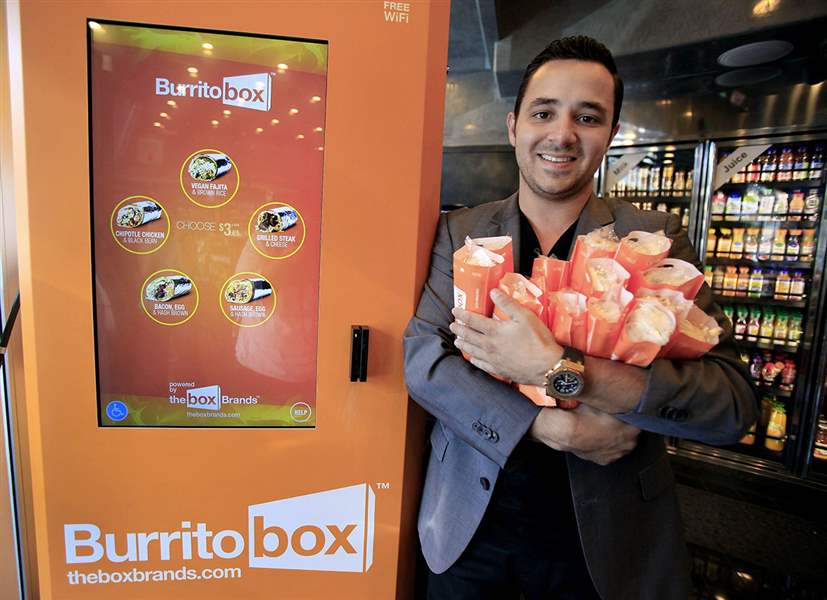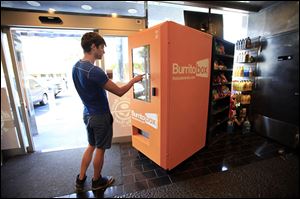
dispensing with ordinary fare
Vending rises to another level
Machines go high tech, offer more than candy bars
8/7/2014
Denis Koci, in West Hollywood, Calif., is the mind behind the Burritobox, a machine that cooks and sells burritos.
LOS ANGELES TIMES

Denis Koci, in West Hollywood, Calif., is the mind behind the Burritobox, a machine that cooks and sells burritos.
LOS ANGELES — At Hollywood and Highland Center, mere steps from Hollywood Boulevard’s souvenir-hawking dives, tourists can drop up to $1,000 on fine caviar.
But they aren’t pampered with white-glove service. Tins of the delicacy are dispensed at the tap of a button — from a vending machine.
After decades of dispensing junk food, vending machines are putting on airs.
High-tech versions are popping up at gas stations and shopping malls, peddling edibles more commonly found at restaurants or specialty stores. Some offer Wi-Fi and touch screens that entertain shoppers while they wait. Many accept credit or debit cards, and a few even sell expensive items such as jewelry.
“There is a lot of innovation happening in vending machines,” Omar Khedr, an analyst at IBISWorld, said. “It’s occurring in niche markets like organic foods, propelled forward by access to new technology and convenience.”
Sprinkles Cupcakes is installing its “Cupcake ATM” at all 16 bakeries around the country. L’Oreal tested a vending machine in New York during the holidays that scanned a shopper’s outfit and recommended complementary makeup. San Francisco start-up Momentum Machines is making a device that cooks up customized burgers with no help from human hands.
Such vending extravagance is driven by consumers with increasingly picky tastes who still want convenience on the go. The boom in mobile and Web-based shopping also has trained customers to browse and buy with no help from salespeople or waiters.
“It’s a case of technological innovation at an affordable price,” said Christopher Salyers, author of Vending Machines: Coined Consumerism. “The Internet has only proliferated this worldview of pay-and-click consumers.”
Long before McDonald’s, coin-operated vending machines served pies and sandwiches to armies of harried workers. But the United States has fallen behind Europe and Asia, where futuristic machines offer a vast array of goods including gold bars, eggs, and live beetles.

Vending machines are dispensing cupcakes, offering wardrobe advice, and Jamba Juice.
After five straight years of decline, revenue for the U.S. vending machine industry is projected to rise and hit $7.7 billion in 2019, up nearly 7 percent from this year, according to an IBISWorld report.
Denis Koci said he spent five years developing the technology for the Burritobox, which offers warm burritos on demand. His Los Angeles company, the Box Brands, rolled out six machines this year in the Southland and in August will start franchising nationally in places such as colleges, Mr. Koci said.
Diners can pick between options such as hand-rolled vegan fajita burritos for $3.65 and add sides such as guacamole and sour cream. Soon the boxes will toast the burritos and offer warmed chips with salsa. The products are heated inside to 195 degrees before popping out.
Jamba Juice has installed JambaGo machines in hundreds of schools. Last year, the Emeryville, Calif., company put about 1,400 machines in places like Target and has 1,000 more planned this year.
“There is a huge opportunity to offer healthier alternatives to kids,” said James White, Jamba Juice’s chief executive. “It’s about making the brand more accessible.”